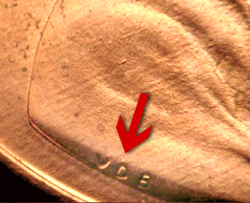Counterfeits: Buyer Beware
|
"Making Cents"
The Signal
Saturday, April 8, 2006
| A |
The owner could not recall how he acquired the two coins, but did remember buying them from someone — probably another young collector at the time (1960s-1970s).
Unfortunately for most collectors, these two coins have been extensively altered, and even die-struck counterfeits are known.
Among the faked coins I have seen in recent years: 1937-D three-legged Buffalo nickels where the missing leg was buffed off, 1916-D Mercury dimes with added "D" mint marks 1931-S Lincoln cents with altered dates (usually from 1936-S or 1937-S cents), and copper-plated 1943 cents.
The last one is the easiest to detect — by using a magnet. The 1943 steel cents are magnetic and the genuine 1943 bronze cents are not.
The other coins require both good eyesight and a quality lens of at least 10 power. In addition, each of the genuine scarce coins has other die features to distinguish them from altered or counterfeit coins.
The American Numismatic Association had a booklet on these and other commonly counterfeited and altered coins, detailing the features to look for. For example, an altered 1914-D cent shows traces of "VDB" at Lincoln's shoulder. The genuine coin does not have "VDB." The 1909-S VDB has a distinctive mint mark found only on coins minted from 1909 to 1915. The three-legged Buffalo has several die features that differentiate it from other 1937 nickels. This is true of the many other dates that fakers have chosen to imitate.
A more recent type of fakery is switching holders. A collector showed me a General Services Administration holder with a 1884-CC silver dollar that he bought on eBay. The coin was indeed a 1884-CC dollar. However, it certainly was not in uncirculated condition. The holder had been carefully split open and a coin of lesser value inserted in place of the original.
On a bid board, I saw what seemed like a 1950 proof set in a custom three-piece holder. Closer examination showed that the half dollar was polished, and the other coins were less than Proof-65 quality — so it was a four-proof-coin date set with a polished 1950 half dollar, listed as a "1950 Proof set."
When buying fairly expensive coins, it is essential that the buyer get a money-back guarantee from the seller if the coins prove to be altered or counterfeit. For coins that are certified, the guarantee is in the maker of the holder, such as PCGS, NGC, ANACS or others.
Collectors should rely on their eyesight and a good magnifier when buying expensive coins. If the coin looks suspicious, do not buy it.
Counterfeiting is not new. Many excellent fakes were made in the 1800s and 1900s, and some reside in major collections today.
Dr. Sol Taylor of Sherman Oaks is president of the Society of Lincoln Cent Collectors and author of The Standard Guide to the Lincoln Cent. Click here for ordering information.
©2006, THE SIGNAL · ALL RIGHTS RESERVED.
